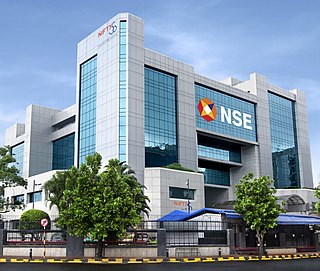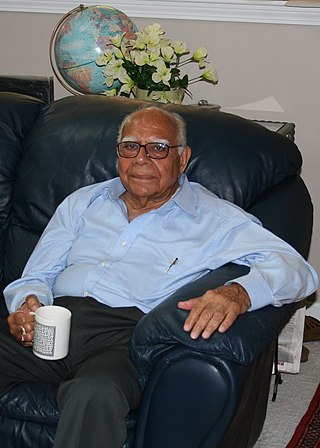
The Securities and Exchange Board of India (SEBI) is the regulatory body for securities and commodity market in India under the administrative domain of Ministry of Finance within the Government of India. It was established on 12 April 1988 as an executive body and was given statutory powers on 30 January 1992 through the SEBI Act, 1992.

BSE Limited, also known as the Bombay Stock Exchange (BSE), is an Indian stock exchange which is located on Dalal Street. Established with the efforts of cotton merchant Premchand Roychand in 1875, it is the oldest stock exchange in Asia, and also the tenth oldest in the world. The BSE is the world's 6th largest stock exchange with a market capitalization exceeding US$5 trillion on May 21, 2024.

National Stock Exchange of India Limited (NSE) is one of the leading stock exchanges in India, based in Mumbai. NSE is under the ownership of various financial institutions such as banks and insurance companies. It is the world's largest derivatives exchange by number of contracts traded and the third largest in cash equities by number of trades for the calendar year 2022. It is the 7th largest stock exchange in the world by total market capitalization, exceeding $5 trillion on May 23, 2024. NSE's flagship index, the NIFTY 50, is a 50 stock index that is used extensively by investors in India and around the world as a barometer of the Indian capital market. The NIFTY 50 index was launched in 1996 by NSE.

Ram Boolchand Jethmalani was an Indian lawyer and politician. He served as India's Union Minister of Law and Justice, as chairman of the Indian Bar Council, and as the president of the Supreme Court Bar Association.
Ketan Parekh is a former stockbroker from Mumbai, who was convicted in 2008 for involvement in the Indian stock market manipulation scam that occurred from late 1998 to 2001. During this period, Parekh artificially rigged prices of certain chosen securities, using large sums of money borrowed from banks including the Madhavpura Mercantile Co-operative Bank, of which he himself was a director.

Sucheta Dalal is an Indian business journalist and author. She has been a journalist for over two decades and was awarded a Padma Shri for journalism in 2006. She was the Financial Editor for the Times of India until 1998 when she joined the Indian Express group as a Consulting Editor, leaving in 2008. She is known for exposing the 1992 stock market scam done by Harshad Mehta.
Haridas Mundhra was a Calcutta-based stock speculator who was found guilty and imprisoned in the first big financial scandal of newly independent India in the 1950s.
Sri Venkitaramanan was an Indian civil servant and economist who served as the 18th governor of the Reserve Bank of India between 1990 and 1992, where he oversaw India's actions to tide over the balance of payments crisis. His actions were noted to have helped the country out of the crisis when its foreign-exchange reserves had almost depleted and helped usher in the country's economic liberalisation programme in the early 1990s.

In economics and finance, market manipulation is a type of market abuse where there is a deliberate attempt to interfere with the free and fair operation of the market; the most blatant of cases involve creating false or misleading appearances with respect to the price of, or market for, a product, security or commodity.
Manohar J. Pherwani (1934-1992) was an Indian corporate executive and banker who served as Chairman of the Unit Trust of India (UTI), National Housing Bank (NHB) and Infrastructure Leasing & Financial Services (IL&FS). Under his tenure of almost a decade as the chairman of UTI, the asset base of UTI grew from ₹1 billion to about ₹176.5 billion
National Spot Exchange Limited (NSEL) case relates to a payment default at the National Spot Exchange Limited that occurred in 2013 involving Financial Technologies India Ltd, when a payment default took place after a commodities market regulator, the Forward Markets Commission (FMC), directed NSEL to stop launching contracts. This led to the closure of the Exchange in July 2013.

Hansal Mehta is an Indian filmmaker. He started his career with television show Khana Khazana (1993–2000) and later moved on to directing films like Dil Pe Mat Le Yaar!! (2000), Yeh Kya Ho Raha Hai? (2002) and Woodstock Villa (2008). He received critical acclaim with Shahid (2013), for which he won the National Film Award for Best Direction. He was nominated for a Filmfare Critics Award for Best Film for Faraaz (2023). He directed the television series Scam 1992 (2020), for which he won the Filmfare OTT Award for best director and Scoop (2023), which won the Asia Contents Awards & Global OTT Award for best Asian television series.
Madhavpura Mercantile Cooperative Bank (MMCB) was a Gujarat-based interstate cooperative bank that became defunct and lost its licence after it was unable to pay back the money it owed public depositors. Reserve Bank of India cancelled its licence in June 2012 under section 22 of the Banking regulations Act, 1949.
Since the beginning of the Bombay stock exchange, stock markets in India, particularly the Bombay Stock Exchange and National Stock Exchange of India have seen a number of booms as well as crashes.
The NSE co-location scam relates to the market manipulation at the National Stock Exchange of India, India's leading stock exchange. Allegedly select players obtained market price information ahead of the rest of the market, enabling them to front run the rest of the market, possibly breaching the NSE's purpose of demutualisation exchange governance and its robust transparency-based mechanism. The alleged connivance of insiders by rigging NSE's algo-trading and use of co-located servers ensured substantial profits to a set of brokers. This widespread market fraud came to light when markets' regulator, the Securities and Exchange Board of India (SEBI), received the first anonymous complaint through a whistle-blower's letter in January 2015. The whistle-blower alleged that trading members were able to capitalise on advance knowledge by colluding with some exchange officials. The overall default amount through NSE's high-frequency trading (HFT) is estimated to be ₹500 billion over five years.
Circular trading is a type of securities fraud that can take place in stock markets, causing price manipulation and often related to pump and dump schemes. Circular trading occurs when identical buy and sell orders are entered at the same time with the same number of shares and the same price. As a result, there is no change in ownership of shares, but there is the appearance of an increased trade volume. Circular trading can be achieved by several parties colluding to achieve the fraudulent outcome. This is not to be confused with wash trading, which is where the same outcome is achieved but occurs through the actions of one investor, rather than a group.

The Big Bull is a 2021 Indian Hindi-language crime drama film directed and written by Kookie Gulati, based on stockbroker Harshad Mehta who was involved in financial crimes over a period of 10 years during 1980–1990. The film stars Abhishek Bachchan, Ileana D'Cruz and Nikita Dutta. It entered production in September 2019, and was digitally released on 8 April 2021 on Disney+ Hotstar. The film received mixed reviews, praising Bachchan's performance, but criticized in comparison to the much acclaimed Scam 1992, which was also based on Mehta's life.
The 1992 Indian stock market scam was a market manipulation carried out by Harshad Mehta with other bankers and politicians on the Bombay Stock Exchange. The scam caused significant disruption to the stock market of India, defrauding investors of over ten million USD.

Scam 1992 – The Harshad Mehta Story is an Indian Hindi-language biographical financial thriller streaming television series on SonyLIV directed by Hansal Mehta, with Jai Mehta serving as the co-director. Based on the 1992 Indian stock market scam committed by many stockbrokers including Harshad Mehta, the series is adapted from journalist Sucheta Dalal and Debashish Basu's 1992 book The Scam: Who Won, Who Lost, Who Got Away. The screenplay and dialogues were written by Sumit Purohit, Saurabh Dey, Vaibhav Vishal and Karan Vyas.
M. N. Goiporia was an Indian career banker who was the 14th chairman of the State Bank of India.









